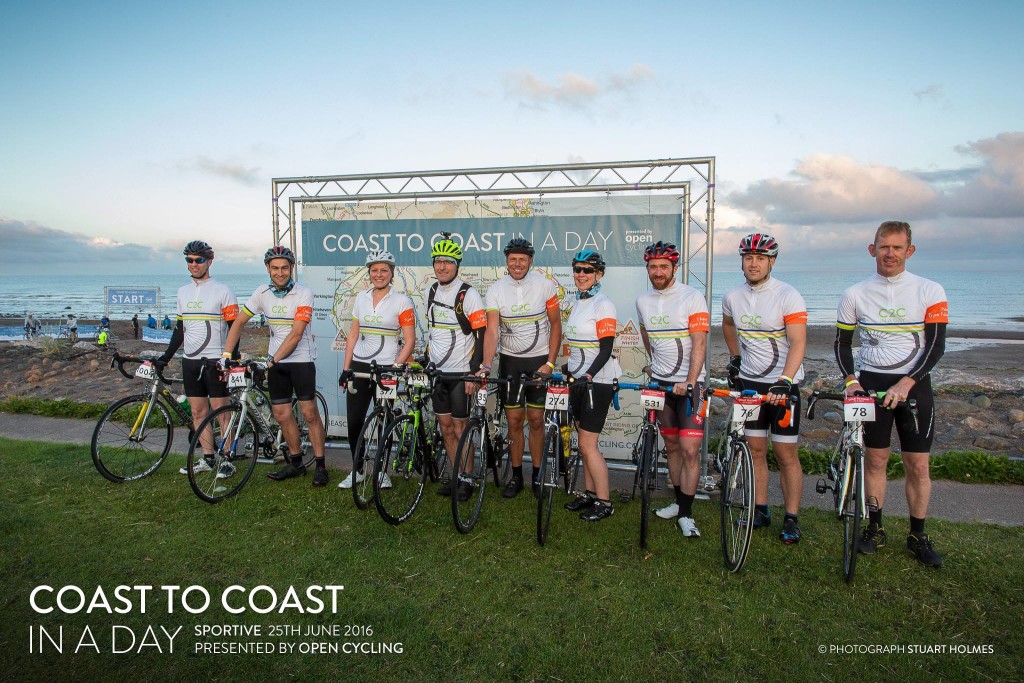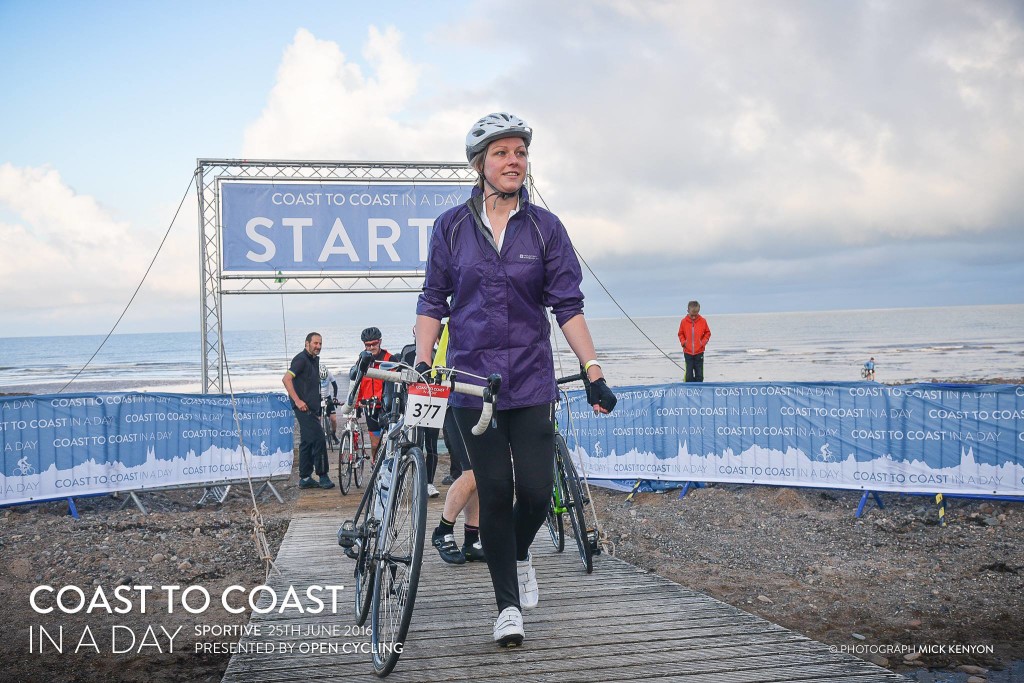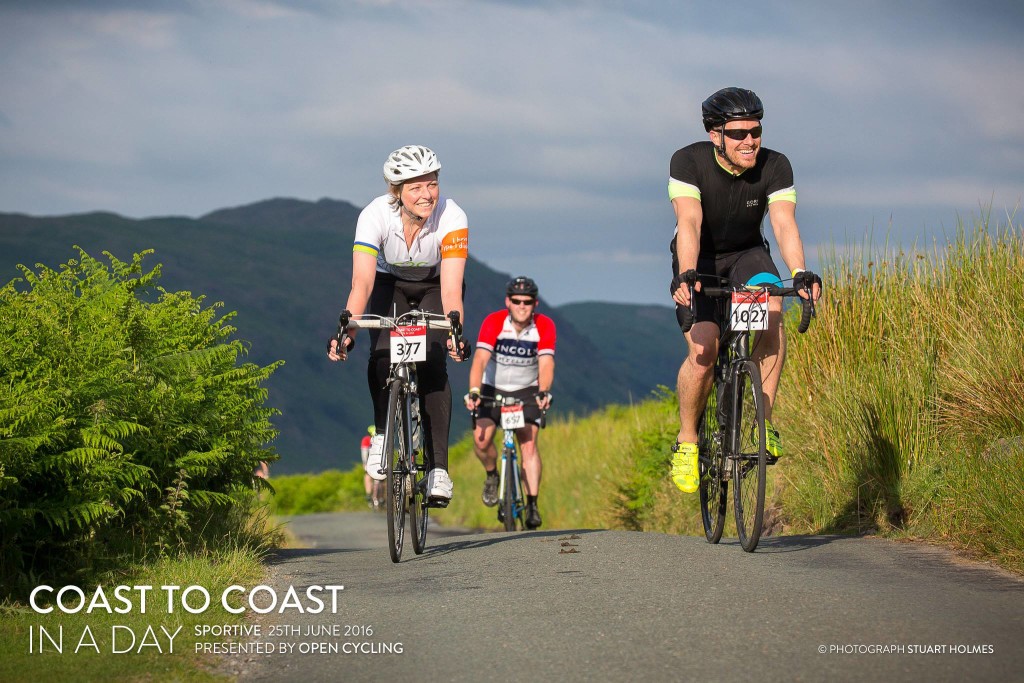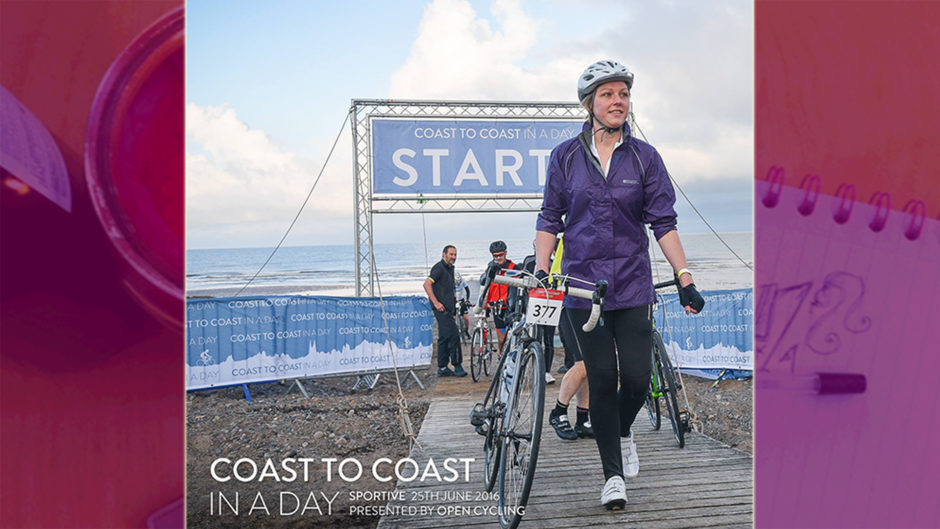So it turns out you can cycle the width of the country in a day, but you can’t tell the tale in one post. I hit 3800 words (OUCH) and just couldn’t do it to you guys. It’s now split in two, and herein lies part one of my adventure.
So. We cycled the width of the country.
I made no secret of the fact that I was utterly terrified as this drew closer and closer. A mix of excited anticipation, nervous terror and moments of absolute disbelief in myself for taking this on. How, due to my current geographical circumstances, I felt in no way as prepared as I did last time I threw myself full pelt into the ups and downs of a ridiculous physical challenge – the one that was, in my mind, the making of me.
Let me tell you now – Coast to Coast is not a challenge to be taken lightly. This is not one that allows you to just turn up and see what happens. It is an Everest of a challenge – pro-cyclist or not, and pro-cyclist I most certainly am not. I’m writing this now, still aching in my legs, still itchy from insect bites, because now that it is over and I have the medal to prove it, I am in grave danger of romanticising about just how tough it really was. Our humble, kind organiser James asked me as I crossed the finish line, how I’d found it.
‘It was both the best and worst thing I’ve ever done in my life,’ I replied.
And if you choose to read no further, that’s the takeaway, folks.
And so the challenge was thus: 150 miles of cycling, in one day. From one side of the country to the other, using only my legs to get me there. With 4500m of ascent (and descent, which it turns out is almost as perilous), totalling half the height of Everest. Oh, and a chronic condition to manage throughout.
Suuuuuuuure.
The night before the big day, tucked up in our lovely Cumbrian guesthouse room with the lights out before 9pm, Ian and I tried to sleep. We’d both had a long day of travelling and we knew the following day was set to be physically and emotionally draining. Unsurprisingly, sleep evaded us. A groggy start was made worse thanks to a waking blood sugar of 16.1 – hilariously the highest waking BG I’d had in months – despite a pre-bedtime blood sugar of 5.9. Special thanks to the coconut milk in the previous night’s Thai green curry for that one. I should have known better. I should have extended my bolus to account for the obscene amount of fat in that innocent looking bowl, but I was far too focused on the carb-loading side of the matter.
Shoulda, woulda, couldn’t do anything about it at 4am the next morning. Except bolus. Bolus lots.
I wasn’t hungry, but I ate a small breakfast anyway for the energy. We tried our best not to wake the other guests as we creaked around the dining room in the dark looking for milk, accidentally clattering cutlery as we went. It was the first of many, many ridiculous situations we’d find ourselves in that day.
We packed up with one eye open, and pedalled five miles to the start line. What’s an extra five miles when you’ve got 150 to go, right? Well, it’s a choice you don’t have when the taxis big enough to fit bikes in are all booked out. We were nervous, but in good spirits, helped by the most stunning sunrise I’ve ever seen in my life.

Team ‘I didn’t need my pancreas anyway’
I met James, and dear Dave who was brave enough to take on the ride too, despite not even owning a bike a year ago. It was nice to see a couple of friendly faces in a sea of very professional looking cyclists. We registered, had a quick photo as a crew of slightly bewildered type 1s, and then there was nothing left to do but start.

‘Oh I’m sorry, you appear to think I’m about to cycle the width of the country. You must have me mistaken for an actual athlete. Back to bed?’
Don’t get me wrong – we had trained. My nerves came from being well aware of what we’d let ourselves in for, as opposed to the naivety of the unknown. We had spent many, many hours on the bike in the previous months, learning valuable lessons and building vital strength. I’d learnt to turn my basal off, but not before my bloods had dropped to 5, as they would generally hold steady until I was around three hours into riding, when I knew I would get a sudden dip. I knew to turn my basal back on around half an hour before finishing to avoid a post-ride spike. I knew to bolus for only a third of the carbs in anything I consumed while riding, but only once I had been cycling for two hours, and after four hours to reduce this to just a fifth of the normal dose. It sounds bloody complicated because it is, but with practice it all starts to take shape.
I’d finally become more comfortable in my cleats. I knew my stamina would dip around 40 miles in, but that it would pick up again as long as I’d fuelled my ride properly. I knew I needed two layers of padding to protect my areas (plural), but that a seat cover was not the answer. I knew I needed a waterproof, and sun cream, and a spare insulin pod. I knew I needed to move the pod from its favoured spot to my outer thigh, as my riding position was too aggressive for it to stay on my lower tummy.
So there we were. Seascale, Cumbria. Mile 1. We started pedalling, and even though it felt good, and exciting, and real, it very quickly became clear just how slow I was amongst lads who clock up 100+ miles of a Saturday morning without breaking a sweat. But this was about finishing full stop, not about finishing fast. I was lulled into a false sense of comforting rhythm as we breezed along, the air cold but full of the lingering promise of a sunny day. Our legs were getting used to turning, and we were slowly waking up.
We were on a gentle incline when I heard that familiar and dreaded, yet unmistakable alarm. My pump had failed. I couldn’t stop myself from audibly shouting: ‘You have GOT to be kidding me,’ waking up a few local residents and the odd local sheep no doubt. I knew instinctively that it was a combination of wind and cold temperatures; something that had thwarted my trusty Omnipod before. Nonetheless I balked at the injustice of its demise, having consciously moved my pump to a safer position. Supremely annoyed at having to stop so soon, I ham-fistedly dug the spare pod out of my saddlebag. A cursory scan with the Libre and my stomach dropped – I had climbed to 20.9. I had been hyper for hours. I rubbed my frozen leg and pleaded with the second pod to hold out as I primed it. It clicked into life, but for how long? I didn’t know. It was my only spare, on the basis that I had assumed it would stay in the bottom of that saddlebag, where it had stayed for months through training, untouched. Here we were, 7 miles in to the real deal and I was out of back ups. This wouldn’t have been an issue if my bloods were in the normal range – I was set to turn my basal off for the duration of the ride. But 20.9 was not only high, it felt dangerous. As I administered a correction dose, my kidneys groaned with slight dehydration just to hammer the point home – clearly upset by all the work they were being made to do that morning, having been working overnight to accommodate Thai Green Curry Gate.
We cycled on another 5 miles, subdued. We stopped again, having contemplated what my next move should be, entirely frustrated at not being allowed to devote my energy to the ride. Diabetes was threatening to take the whole event – and months of training – away from me; from us, and from the sponsors that had so generously donated some of their hard earned to our cause. If I was going to fail the ride, I wanted to fail on my terms, which as you’re well aware, usually consist of outrageous stupidity, unfortunate calamity or (more likely) a mix of both. I cried for a minute or so to get all the emotion out (nifty trick btw, it works) as Ian held me tight. The absurdity of it – stranded in the middle of nowhere at 6am, both stood, motionless, head-to-toe in Lycra while I blubbed into his waterproof as he offered me gentle reassurance. So absurd it was almost hilarious. I found my resolve at the bottom of the tears and pulled myself together, ploughing extra insulin in on the basis that if this second pod also failed, I would at least have excessive correction in my system and not in the redundant pod where I couldn’t access it. Between us we had a sweet shop’s worth of sugar to catch the inevitable hypo. I simply had to get my bloods down if I was going to stand any chance of safely carrying on.
Ever the voice of logic, Ian asked quietly: ‘If this one fails, what’s the next step? The hospital?’
Until that point I hadn’t realised that yes, it probably was.
We pedalled, and the sun rose from behind the awesome terrain that towered above us. We knew the toughest climb, Hardknott Pass was looming. 393 metres of climbing, with a 30% gradient at the steepest point. With my confidence somewhat knocked, poised to hear the alarm that signified the second pod failure – and probably game over – at any moment, I was now terrified of pretty much everything, and annoyed at myself for getting it so wrong, and sad for Ian to have to consider all this by proxy when we’d both invested so much to get here. Guilt that I’d slowed him down too, and given him extra stuff to worry about.
I had decided to walk the steeper parts of this ominous climb mountain long ago, when I knew I wasn’t training as much as I wanted or needed to. As we reached the innocuous red phone box that signified the start of the mammoth ascent, I no longer felt amped enough to even begin to attempt it. In order to save my cleats, out came the fold-up flat shoes (the best £4 I’ve ever spent in Primark, it turns out) and began to climb on foot, awestruck at the power of the cyclists who pushed past, grunting and panting and inwardly competing with themselves, telling themselves to keep pushing, keep turning.
It was at least 15 minutes before I made it to the very top, also panting and grunting, and allowed myself to turn around. I gasped as I took it all in. It was hard to be angry or sad or scared with such a stunning view. Every angle, every direction, as far as you could see. It was breath-taking. And I was alright. I could feel the blood in my system was pumping properly, and I could feel the muscles in my legs were no longer frozen. ‘I might just be ok,’ I dared myself to think.
Onwards.

Me and my #1 buddy.
The expected crashing blood sugar arrived about half an hour later, just as we were tackling the second biggest climb of the day, Hardknott’s slightly less imposing neighbour, Wrynose Pass. The Libre (aka MY SAVIOUR) showed a pretty much vertical line downward, and I stopped to inhale sweets at a lightening rate, switching my basal off and thanking the sky that the second pod had survived. I was safe now. It was still early, but it was already hot as the sun beamed down with serious intent. As long as I kept pedalling, and ate at the right points, my bloods would stay flat.
I was emotionally exhausted. With 130 miles to go.
Onwards.


3 Comments
Love this, I really wanna read part 2 now! I can’t believe your pump packed in, whyyyyy! I think I would have just burst into tears and cried and cried! Massive well done for carrying on despite things not going to plan – amazing stuff!
Hello lovely! Sorry for the delay – thanks so much for reading and commenting! It was all a bit dramatic for my liking but I should know to expect nothing less by now! I hope you’re well x
That’s a hard first 20 miles! Well done for carrying on; that’s a big deal with failing pumps and high blood glucose to deal with too. Kudos. 👍
I’ve been on insulin for 48 hours now and have about 50 miles planned for tomorrow, so I’m on a massive learning curve right now. Literally everything is a learning experience; work, eating different foods, long exercise, short exercise, walking to the shops … The list goes on.
Got to know these kind of challenges are possible with Type 1.